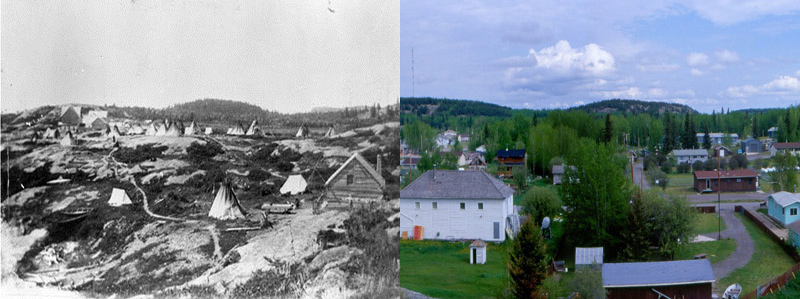Fort Chipewyan in 1899 (Glenbow Museum) and c. 2010 (Arctic-Traveller, Panoramio). An exactly relocated rephotograph is required.
1788: Fort Chipewyan Established
Expansion of the fur trade along the Athabasca River was immediately beset by two major issues. First, in the summer of 1780, either white traders or First Nations brought smallpox into the watershed. The disease had killed numerous people across the plains to the south in1779, and Alexander Mackenzie describes how trader Peter Pond tried to reduce its spread northwards:
In the spring of the year (1780) Mr. Pond sent (a clerk) to meet the Indians from the Northward, who used to go annually to Hudson’s Bay; when he easily persuaded then to trade with him, and return back, that they might not take the contagion which had depoulated the country to the Eastward of them: but most unfortunately they caught it here, and carried it with them, to the destruction of themselves and the neighboring tribes. The country being thus depopulated, the traders and their friends from Canada… began to sink seriously think about making permanent establishments on the Missinipi river, and at Athabasca… In 1781-82… they found , in every direction, the ravages of the smallpox; so that, from the great dimutation of the natives, the returned in the spring with no more than seven packages of beaver. The strong woods and mountainous countries afforded refuge to those who fled from the contagion of the plains; but they were so alarmed at the surrounding destruction, that the avoided the traders, and were dispirited from hunting except for their subsistence. 1
The second related issue facing the traders was the matter of obtaining provisions when wintering in the northern boreal forest. To obtain and store fish, bison and moose, starting in 1788, traders of the North West Company, followed by those from the Hudson’s Bay Company established a series of posts near where the Athabasca River enters Lake Athabasca. Eventually, Fort Chipewyan was built on its present site on the northern shore of the lake. Given its location on several important waterways, this establishment became the “emporium of the north”—an important location for trade and provisioning traders and First Nations living and travelling up the Peace River to the west, up the Athabasca River to the south, or down the Slave and Mackenzie rivers to the north. It was an important meeting place for Dene, Chipewyan, and Cree first nations, and Montrealers (North West Company), and English (Hudson’s Bay Company) traders. The whitefish fishery on Lake Athabasca provided the majority of food for the fort. This was supplemented by wood bison and moose, often found on the ecologically-rich grass and shrublands on the nearby Peace-Athabasca delta, and periodically by caribou hunted in areas more remote from the post. An additional important source of provisions was pemmican obtained from the bison hunted on the grasslands on the Peace River 200 km to the southwest, then processed and shipped down river each spring. Today, Fort Chipewyan can be accessed by automobiles only in winter when the “ice road” is in place, and provides a fascinating example of a community in transition from a long legacy of traditional subsistence trapping, hunting and gathering to industrial age mining, and social and ecological influences from nearby petro-chemical industry upstream on the Athabasca oil sands. 2
<Previous page Chapter Overview Next page>
Map and Footnotes
- Mackenzie, Alexander. The Journals of Alexander Mackenzie: Exploring Across Canada in 1789 and 1793. Santa Barbara, CA: Narrative Press, 200 (Originally published in 1801) ↩
- Parker, James M. Emporium of the North: Fort Chipewyan and the Fur Trade to 1835. Regina, SK : Alberta Culture and Multiculturalism/Canadian Plains Research Centre. 8-11; McCormack, Patricia A. Fort Chipewyan and the Shaping of Canadian History, 1788-1920s: “We like to be free in this country”. Vancouver, BC: UBC Press. 2001 ↩
